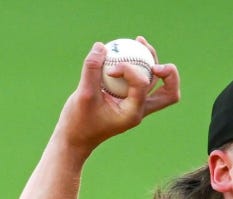It’s been a fun offseason, but games are here. I’ve compiled a list of new pitches among MLB-relevant pitchers which I will leave below with links to sources. I also dropped a video on what 2025’s biggest MLB trend will be. You can watch it on YouTube!
Cristopher Sanchez, PHI (cutter?)
Kevin Gausman, TOR (cutter)
Clay Holmes, NYM (kick-changeup, four-seam tweak, slider tweak)
Jackson Jobe, DET (sinker, curveball)
Max Meyer, MIA (sweeper, sinker)
Paul Skenes, PIT (running 2S, cutter)
Griffin Canning, NYM (sinker maybe)
Casey Mize, DET (splitting slider into 2 pitches)
Jared Jones, PIT (sinker?)
AJ Puk, ARI (changeup)
Graham Ashcraft, CIN (curveball)
Grayson Rodriguez, BAL (old sweeper)
Jake Irvin, WSH (Slider)
Hurston Waldrep, ATL (old curveball)
Bryce Miller, SEA (new cutter)
George Kirby, SEA (cutter)
AJ Smith-Shawver, ATL (cutter)
Tylor Megill, NYM (curveball tweak)
Kyle Harrison, SFG (cutter/slider)
Albert Suarez, BAL (depth SL)
Logan Gilbert, SEA (death ball?)
Slade Cecconi, CLE (sinker, cutter)
JP Sears, ATH (gyro slider)
Ryan Helsley, STL (cutter)
Clay Holmes: Changeup, Four-Seam, Slider
It’s not surprising to see Holmes add or tweak multiple pitches as he transitions from reliever to starter. The changeup he’s throwing is a welcomed addition I speculated on back in November. He trained remotely with Tread Athletics this offseason. The variant he’s using—a “kick-changuep”—is a changeup with a slight spike to help the ball drop more. Leif Strom pioneered it at the North Carolina facility. (You can learn more about it here.) There are only a few versions of the pitch in MLB right now, including Hayden Birdsong and Davis Martin.
I expect the movement profile on Holmes’ changeup to be around -3” to -4” vertical break with 15”+ arm-side movement at 88-90 mph. The average right-handed changeup in baseball last year was 86 mph with 5” vertical break and 15” arm-side movement. If my projection is correct, every variable on Holmes’ new changeup will be better than average. Holmes’ release is also higher than average. Because of that, we’d expect less drop on a changeup from his slot (a higher vertical break number). Holmes, instead, would be getting 8” more drop than average at his high release, a deadly combination. It could grade out as one of the best changeups in baseball. Given that Holmes only struck out 20% of left-handed batters he has faced since 2022, it’s a no-brainer addition.
Holmes also tweaked his four-seamer, a pitch that I don’t expect to have above-average shape, but one that’s necessary to utilize at the top of the zone to lefty bats. There’s also a nugget in the above article that Holmes tweaked his slider to make it more effective versus left-handed hitters. His short gyro slider was his best offering last year to lefties from a run-value standpoint. The pitch averaged -4” vertical break and 2” glove-side movement at 87 mph. This is more drop and less glove-side than your average slider. I consider it a depthy version of a gyro slider that grades out plus. Given that his velocity will drop as he’s stretched out, the current form of the pitch at 84-85 mph may be ineffective. I’d guess the approach is to add back some velocity by sacrificing drop. Perhaps the pitch stays around 87-89 mph but has 2” vertical break. This is a worse offering but maybe preferred to a -6” vertical break pitch at 84 mph.
Holmes throws Saturday in the Mets spring opener.
Quick Hits
Max Meyer going sinker and sweeper is a nice boost to my breakout case. When an organization turns over as much staff as the Marlins did in their pitching department, it feels like low-hanging fruit to assume they’d make logical changes to pitchers who struggled mightily. (Let’s see what they have in store for Edward Cabrera.)
Jackson Jobe adding a sinker and curveball is a fun twist. I see more value in the sinker to right-handed hitters than the curveball. Despite a strong Stuff+ grade, his four-seam has never dominated that handedness, even in the minors. Of 115 starting pitchers with 100 IP or more last season, just 40 have four-seam Stuff+ grades of 100 or better. That’s 35%.
Griffin Canning's potential conversation with new assistant pitching coach Desi Druschel about a sinker aligns well with my bold idea that there’s little reason to use his four-seam fastball.
Bryce Miller had a cutter last season that he threw on occasion. It averaged 92-93 mph with 13.5” vertical break and 0” horizontal movement. Stuff+ gave the pitch a 92, likely connected to it having too much vertical break for that band of velocity. The version he has flashed in side sessions has a lot more glove-side movement. This is a surefire way to improve the pitch quality in the eyes of Stuff+. We’ll see if he holds it in games.
George Kirby flashed a cutter last year in 2 starts while his slider struggled. He then never threw it again and found a harder version of his slider that carried him through the rest of the season. You may remember me documenting the journey because I found it fascinating (here and here). I wonder if the cutter shape he’ll bring into games will be similar to what Gilbert and Miller throw, which is a shape I call the “Yankee Cutter.” It’s a cutter with an inordinate amount of lift and sweep, similar to the shape Miller flashed in his off-season side sessions. Otherwise, Kirby’s 2024 cutter and revised slider are very similar in shape.
Graham Ashcraft’s new curveball should have happened a while ago. There’s an adage that when you spin the ball around 2,800 rpm and can create sweep at velocity (Ashcraft averages 9” sweep at 88 mph), you should throw a minimum of 3 breaking balls.
Kyle Harrison adding another pitch lines up with what a lot of people in the industry, including myself, have thought for some time—his slurve isn’t good enough to be the only glove-side pitch he throws. I’m curious to see what this shape looks like in game.





